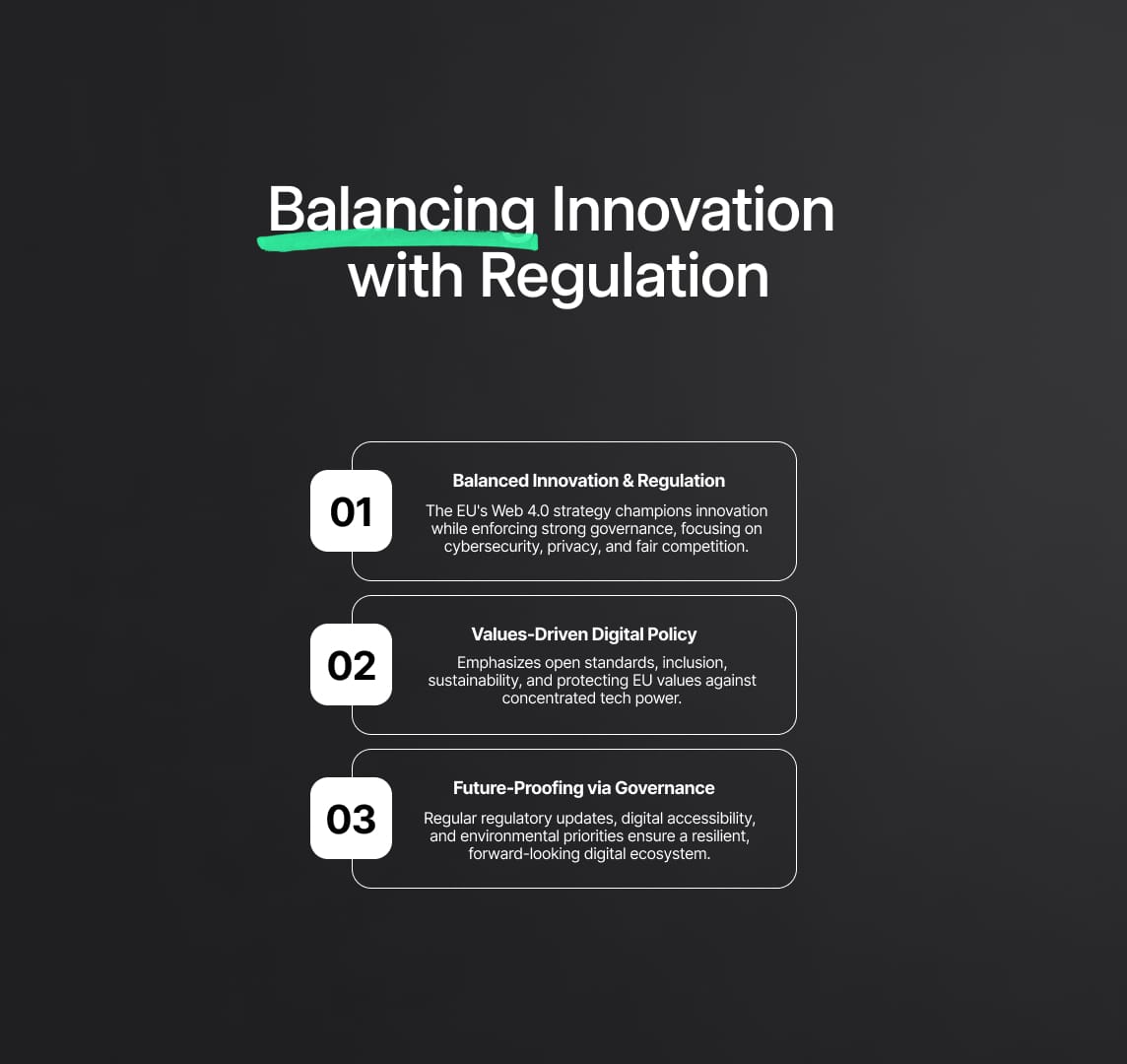Digital Single Market: EU web 4.0 Regulation
The EU's strategic approach to Web 4.0 seamlessly blends proactive governance with visionary foresight. Balancing innovation with robust regulation, the European blueprint emphasizes interoperability, inclusivity, and sustainability.

Digital Single Market: web 4.0 Policies and Regulation
The European Parliament is getting ready for the digital age, especially for the revolutionary change to Web 4.0 and the emergence of virtual reality. The legislature recognizes the significant shifts that digitalization is bringing about in a variety of spheres of our lives, including the political, social, and economic. The digital revolution offers many potential, including improvements in security, education, healthcare, and law enforcement, but it also brings with it a number of difficulties.
These include the need to reevaluate our conceptions of social progress and growth as well as the rise in power of foreign digital behemoths. Aware of these obstacles, the EU has made the digital transition a top priority, developing laws and policies that are consistent with European ideals. The creation of virtual environments and the shift to Web 4.0 are seen as essential to the realization of the digital single market. On the other hand, there are significant concerns associated with cybersecurity, consumer protection, privacy, and personal data protection. The European Union is taking a positive and proactive approach, praising recent legislative advancements and pledging to keep an eye on how virtual worlds grow.

Digital Single Market & Web 4.0: Balancing Innovation with Regulation
The digital revolution that the European Union (EU) is about to experience is being driven by the revolutionary possibilities of Web 4.0 and the expanding field of virtual worlds. The EU's strategic approach, which combines visionary foresight with proactive governance, is a model for other global powers to follow as we navigate the digital future.
The understanding of the significant effects that the digitalization wave has on a variety of industries, from security and law enforcement to medicine and education, is at the heart of the EU's digital roadmap. But this wave is about more than just seizing the chance; it's also about tackling the complex problems. The EU's top priorities continue to be addressing the concentrated power of foreign digital giants, reevaluating growth models, and making sure that European ideals and values are ingrained in digital policy frameworks.
The EU's approach is notable for its steadfast dedication to open standards and interoperability. This commitment aims to provide fair conditions so that all parties involved—from well-established IT giants to recently formed SMEs—can prosper in a well-balanced digital ecosystem. This kind of openness supports diversity and serves as a foundation for the goals of a healthy and just digital marketplace.
Moreover, the EU's focus on cybersecurity, data privacy, and consumer protection demonstrates the careful preparation that went into developing its regulations. The European Union, via its advocacy of a comprehensive regulatory framework, is well-positioned to achieve a harmonious balance between safeguarding and facilitating innovation. This balance is especially important in light of the dangers of moving to Web 4.0 and the complexity of virtual worlds.
One further admirable aspect of the EU's agenda is its push for inclusion. The union is changing the digital narrative for people with disabilities by advocating for digital accessibility and creating settings that are both accessible and supportive of meaningful relationships. This is paired with the EU's environmental awareness. With sustainability in mind, there's a definite trend toward using cutting-edge recycling techniques and relying more on renewable energy sources to maintain an environmentally conscious digital footprint.
Given the rapid changes in the digital ecosystem, the EU's commitment to conducting periodic regulatory fitness assessments has the potential to establish a gold standard for digital governance. The union's intention to maintain flexible, responsive, and up-to-date regulations is emphasized by this proactive strategy.
Essentially, the EU's Web 4.0 plan is a master class in striking a balance between innovation and regulation as we move towards a future that is increasingly digitally connected and integrated. Through prioritizing sustainability, equity, and resilience, the European Union is actively shaping the future rather than merely preparing for it. Understanding the EU's strategy can provide firms, governments, and digital enthusiasts eager to capitalize on the opportunities presented by the digital age with essential insights and strategic guidance.
Reduce your
compliance risks

